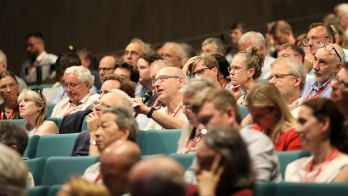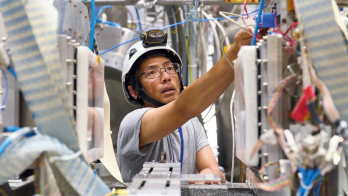
A premature end to SLAC’s B-factory, a stop to UK investment in the International Linear Collider (ILC) project and more than 300 lay-offs at Fermilab and SLAC – 2007 ended on a bad note. Do these cuts in the US and the UK signal a general downturn for particle physics? No! In the UK they are the combined result of organizational changes and an emphasis on national facilities(see Particle physics in the UK is facing a severe funding crisis). In the US they arose from disputes in congress; and there at least, the US president’s budget for FY2009 looks more positive. The reasons for these cuts are thus too specific to call them a trend – all the more since, for example, KEK’s five-year plan strongly endorses ILC research and funding has increased recently in countries such as Germany.
We have seen frequent ups and downs in funding over the decades. So is it business as usual? Not quite. Nowadays, these ups and downs must be seen in the framework of global co-operation and the interdependence of projects in particle physics.
The size and cost of our facilities are so large that they can only be realized in a truly international context: a machine like the LHC will exist only once in the world. Equally, it would be inefficient to clone billion-euro projects for future neutrino physics, super B-factories or astroparticle physics. Moreover, the R&D necessary for high energies and intensities for future accelerators – and for future detectors – can only be performed in a stable and organized worldwide effort.
In theory, everyone agrees that a global distribution of responsibilities is the most cost-effective approach, allowing particle physics to make the best use of worldwide interests and expertise, and guaranteeing a broad and complementary exploration of our field. Making this a reality, however, is another business. It requires agreements at a transnational level and, in particular, reliability and continuity of support.
Here we evidently have a problem: although international in character, funding of high-energy physics projects is, and will be, largely national. There are few internationally binding treaties like the one for CERN, generating a stable financial situation. Most agreements are memoranda of understanding or even less formal. Common goals are subject to the “good will” of national funding and therefore to changing economical situations and national political and scientific priorities. Particularly vulnerable are the projects that require significant R&D without clearly defined financial contributions.
We can only progress if we repeatedly make it clear what it is we give back to society in return.
In addition there is the mere fact that supporting national facilities is politically easier than financing international ones. Which representative would lobby for a project that is not in their country or constituency? Surely it is better to cut the ILC than the local research facility.
Consider the example of the ILC more closely. The consensus is that it will be the next big machine, and that there will be only one machine. Even if the ILC is not imminent, R&D is mandatory to optimize costs and come to a technically sound proposal. Following this ideal, the worldwide community formed a global network and began to develop special expertise (see Barry Barish and the GDE: mission achievable). The UK, for example, was leading the effort on damping rings, beam delivery and positron sources. Ceasing support for ILC R&D in the UK therefore cuts a large hole in the international network. Who can take over – and at what cost? Yes, stopping R&D saves money in the short term, but in the long term it will cost more. Maybe even more damaging, a loss of confidence in pursuing projects internationally could result.
What can we conclude? Well, the first point is rather trivial: particle physics is part of society. We are not free from general economic constraints and we have to compete with important social, political, ecological and scientific goals. We can only progress if we repeatedly make it clear what it is we give back to society in return.
However, we really need a more organized way of setting internationally agreed priorities, with more binding definitions of national responsibilities and financial commitments for large-scale projects, including their R&D phase. The CERN Council strategy group, together with the funding agencies in the CERN council, is an important tool and should be a step towards a transcontinental equivalent. Note however: even this is no guarantee for reliability, as is evident from the termination of US contributions to the ITER project.
CERN, as any other laboratory hosting a large-scale facility, should see itself as an important part of a large network, serving the interests of its members and contributing states. Universities and national laboratories should not be seen as an appendix, but as key participants. We should work actively to make it evident in all countries that contributing to CERN eventually feeds back into domestic technological and scientific progress.
An excellent and successful LHC project is key to further international co-operation in particle physics. If nature reveals new effects and causes public excitement, many problems we face now will be easier to solve.








